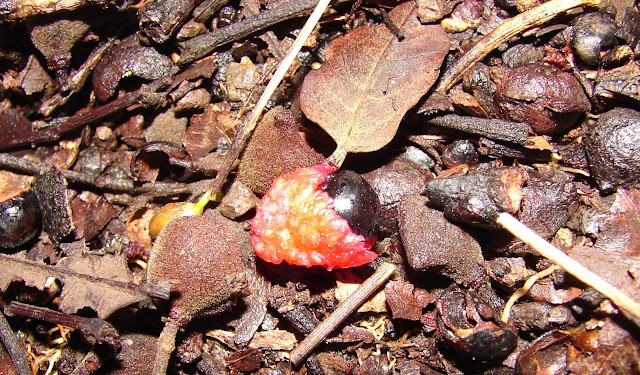Alectryon excelsus, titoki or NZ ash (formerly known as NZ oak) is endemic to the North and South Islands, and is found from Te Paki in the north to Banks Peninsula in the south, and somewhat further south in Westland. It is a common offshore island tree within the Hauraki Gulf. It is a widespread coastal to lowland forest tree that often favours well drained, fertile, alluvial soils along river banks and associated terraces from sea-level to 600m asl. It is also a major component of coastal forests, particularly those developed within exposed situations or on basaltic or and andesite volcanics. Titoki is a canopy tree growing to 9 metres in height with a twisting trunk with smooth dark bark, spreading branches and feather-like leaves. It produces small purple flowers from October - December (-June) followed by fruit November – August, and the seeds take up to a year to mature. The colourful seed is initially contained in a hairy woody capsule which splits revealing bright red and black unpalatable fruit (the black portion being the seed). Titoki fruit are a favourite food of the New Zealand Wood Pigeon.The large fruits are bird dispersed and so titoki trees often occur as a sparse components of most lowland forest types, throughout the North Island. Grows quickly in suitable conditions, preferring well drained, fertile soils in full sun or partial shade. A popular street tree, and as the fruit is bird dispersed it often naturalises in gardens from street side plantings.
Sunday, 20 January 2019
Subscribe to:
Post Comments (Atom)
Leptinella squalida subsp. mediana is endemic to the South and Stewart Islands. It is found from northwest Nelson and inland Marlborough to...

-
Olearia odorata or scented tree daisy is endemic to the South Island. Its is found in lowland and montane shrubland and scrub, in the easter...
-
Dacrydium cupressinum, rimu or red pine is endemic to the North, South and Stewart Islands - uncommon in large parts of the eastern South Is...
-
Leptinella squalida subsp. mediana is endemic to the South and Stewart Islands. It is found from northwest Nelson and inland Marlborough to...






No comments:
Post a Comment